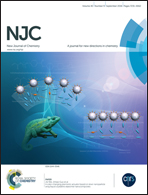Anti-proliferative activity and DNA/BSA interactions of five mono- or di-organotin(iv) compounds derived from 2-hydroxy-N′-[(2-hydroxy-3-methoxyphenyl)methylidene]-benzohydrazone†
Abstract
Five new mono- or di-organotin(IV) complexes, Me2SnL (1), Ph2SnL (2), n-Bu2SnL (3), n-Oct2SnL (4) and n-BuSnCl(H2O)L·CH3CH2OH (5), where H2L is 2-hydroxy-N′-[(2-hydroxy-3-methoxyphenyl)methylidene]-benzohydrazone, were synthesized and characterized by elemental analysis and spectroscopic techniques (IR and 1H, 13C, 119Sn NMR). The crystal structures of all compounds were established by X-ray diffraction, showing the hydrazone Schiff base ligand bound to the tin atom as ONO tridentate chelate. In vitro cytotoxicity determination reveals that all compounds exhibit good activity toward three cisplatin-resistant human cancer cell lines: A549cisR, HeLacisR and MCF-7cisR cell lines. The possible structure–activity relationship of these compounds was studied from the effect of both alkyl groups bound with tin centers and the structure of organotin compounds on their in vitro antiproliferative activities. All complexes can interact with calf thymus DNA (CT-DNA) in the intercalation mode, as evidenced by UV-Vis absorption, luminescence and circular dichroism (CD) titrations. Furthermore, the interaction of all compounds and bovine serum albumin (BSA) in static mode was characterized by fluorescence spectroscopy methods, which were confirmed by the docking study. In addition, further studies reveal that the most active di-n-butyltin(IV) compound, inducing production of ROS, can potentially be used as anticancer drug.
![Graphical abstract: Anti-proliferative activity and DNA/BSA interactions of five mono- or di-organotin(iv) compounds derived from 2-hydroxy-N′-[(2-hydroxy-3-methoxyphenyl)methylidene]-benzohydrazone](/en/Image/Get?imageInfo.ImageType=GA&imageInfo.ImageIdentifier.ManuscriptID=C6NJ00525J&imageInfo.ImageIdentifier.Year=2016)

 Please wait while we load your content...
Please wait while we load your content...